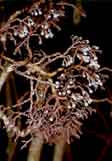
Common Names
Corail (2).Taxonomic notes
Monotypic genus. Syn: Podocarpus ustus, Dacrydium ustus Viellard (1). Recent studies of cuticle micromorphology suggest a close relationship with Lepidothamnus, particularly with L. fonkii (4).Description
A shrub or small tree, 1.0-1.8 m tall (de Laubenfels 1972 in 4).Range
New Caledonia: Pouebo, Bleue R., type from Poila, found at 400-1100 m elevation (1).Big Tree
Oldest
Dendrochronology
Ethnobotany
Observations
Remarks
"[Parasitaxus ustus] has always occupied a unique position ... among conifers in general. It grows in remote, densely forested highland parts of New Caledonia. ... Its uniqueness has derived from the fleshy deep red or purple scale-leaved branches ...."Because of the special interest which P. ustus has aroused, a special effort was made during a December 1957 visit to New Caledonia to collect the elusive plant. One of its areas of occurence was visited, and several plants were seen. This report derives from the fact that one of these plants was growing out of the base of a tree of [Falcatifolium taxoides]. As might be suspected from the fleshy red nature of P. ustus, it is a parasite, certainly sometimes, probably always. The parasitic specimen was collected and has been the subject of a careful study.
"[Parasitaxus ustus] is a woody shrub. In the case of its attachment to [F. taxoides], the largest of two emerging stems had a diameter of about [12 mm] and the host had a diameter of about [8 cm]. The parasitic stem curves sharply so that the root zone is oriented upward. Most of the woody roots travel up the trunk of the host, probably for several feet; a few grow downward for several inches. The modified roots are imbedded in the bark between the cork cambium and the vascular cambium. General stimulation of the vascular cambium has occurred, producing a thickening in both wood and bark tissue. The cambium of the slightly anastomosing roots, significantly, is on the outside toward the cork cambium. No normal phloem is produced, although a tissue full of sclerids opposite the xylem may represent modified phloem tissue. Around the parasitic roots, the host tissue is somewhat disorganized and forms a sheath of abnormally large cells.
"In several ways the specimen of P. ustus reported here is not typical. No other specimen has been seen growing from the trunk of another plant. Typically P. ustus grows on the open forest floor under rather shady conditions (chlorophyll is present in the leaves). Probably most individuals are root parasites. Several attempts by foresters in New Caledonia to dig up small specimens for transplanting resulted in immediate death of the specimens. It was noticed that removing the specimens involved cutting out various tree roots, but, because a parasitic attachment was not expected, it was not looked for. Although [F. taxoides] is closely related to P. ustus, it may not be the preferred host. [Falcatifolium taxoides] is common throughout the highlands of New Caledonia, and the rareness of P. ustus might seem puzzling. ...
"[T]he single specimen upon which this report is based shows unmistakable parasitic modifications. There is no fusion of tissues as in grafting. The xylem strands run through the host phloem. These modified root strands do not show radial symmetry, but do show polarity with respect to the host That parasitism may well be normal in this species, then, is inferred from the definite modifications that have been made for parasitic attachment, together with the general habit of this species which strongly resembles that of known root parasites. In the observed specimen, a seed has lodged against a trunk instead of over a root.
"Until now, all conifers were known to be independent trees, bushes, or trailing shrubs. Podocarpus ustus, in being parasitic, thus differs from all other conifers. In fact no gymnosperm of any kind has previously been discovered in a parasitic relationship to other plants." (3).
Citations
(1) Silba 1986.(2) Maurice Schmid. 1981. Fleurs et plantes de Nouvelle-CalÚdonie. Les Úditions du Pacifique. ISBN 2-85700-117-7, ISSN 0240-0936.
(3) David J. DeLaubenfels. 10 July 1959. Parasitic conifer found in New Caledonia. Science 130: 97.
(4) Ruth A. Stockey, Helen Ko and Philippe Woltz. 1995. Cuticle micromorphology of Parasitaxus de Laubenfels. International Journal of Plant Sciences 156: 723-730.
ABSTRACT: Cuticle micromorphology of three collections of the parasitic conifer Parasitaxus ustus (Vieillard) de Laubenfels (Podocarpaceae) was studied with scanning electron microscopy. External and internal cuticle features of abaxial and adaxial leaf surfaces of both vegetative and epimatium-bearing branches are characterized. Leaves are amphistomatic with an abaxial tip lacking stomata and a small marginal frill. Cuticle is thin and external surfaces exhibit sunken Florin rings and highly undulating epidermal cell surfaces. Stomata have a scattered orientation on the leaf and have three to six subsidiary cells. Cuticle on the subsidiary cells, guard cells, and epidermal cells is smooth to slightly granular. Stomata lack polar extensions. Epidermal cells have variable shapes but are more elongate and rectangular near the abaxial leaf tip and between stomatal groups. Micromorphological characters are compared to those of the host plant, Falcatifolium taxoides (Brongniart et Gris.) de Laubenfels, and Florin's Dacrydium group C species that are considered by some workers to represent three separate genera: Halocarpus Quinn, Lepidothamnus Philippi, and Lagarostrobos Quinn. Micromorphologically cuticles are most similar to those of the genus Lepidothamnus, in particular L. fonkii Philippi, but those of Parasitaxus have less granular epidermal cell surfaces and a more irregular outline to the stomatal apparatus.
See also:
de Laubenfels, David J. 1972. Flore de la Nouvelle Calédonie de dépendances. Vol. 4. Gymnospermes. Paris: Museum National de l'Histoire Naturelle.
back | Parasitaxus | Podocarpaceae | home
This page is from the Gymnosperm Database
URL: http://www.geocities.com/~earlecj/po/sa/index.htm
Edited by Christopher J. Earle
E-mail:earlecj@earthlink.com
Last modified on 13-Sep-1998